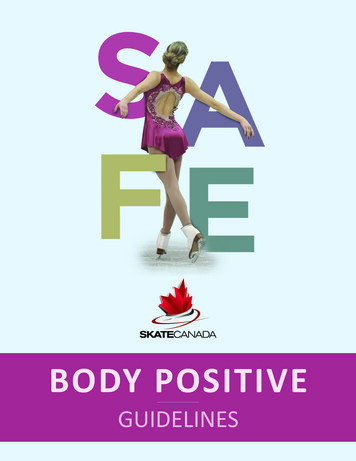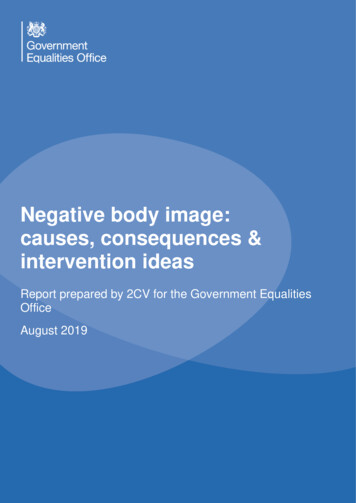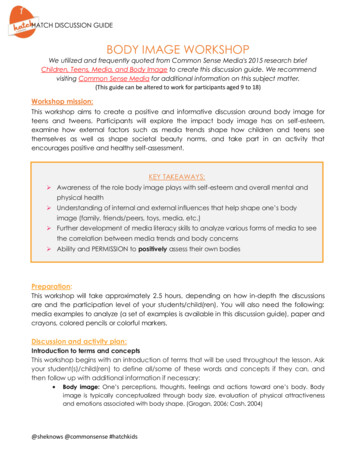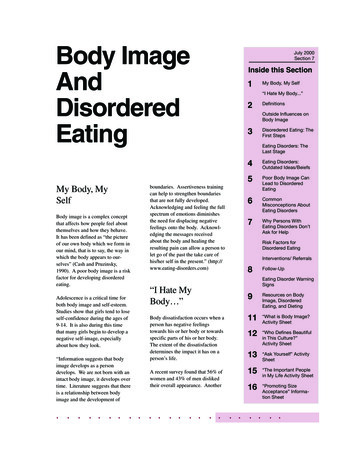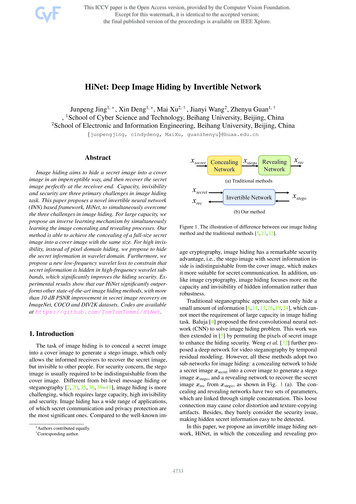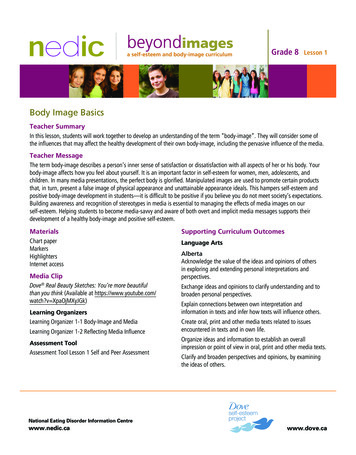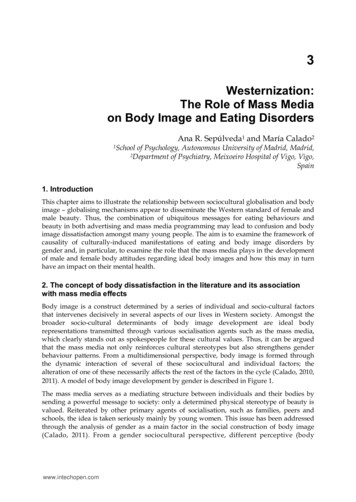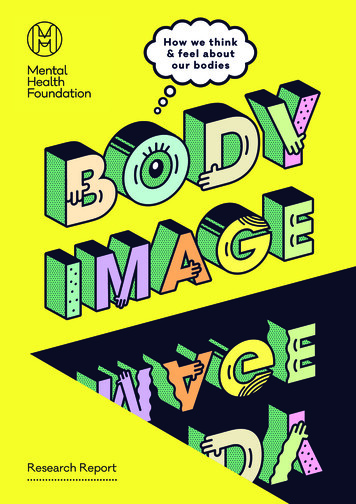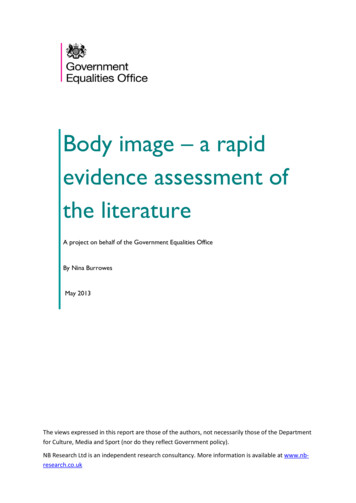
Transcription
Body image – a rapidevidence assessment ofthe literatureA project on behalf of the Government Equalities OfficeBy Nina BurrowesMay 2013The views expressed in this report are those of the authors, not necessarily those of the Departmentfor Culture, Media and Sport (nor do they reflect Government policy).NB Research Ltd is an independent research consultancy. More information is available at www.nbresearch.co.uk
ContentsExecutive Summary21. Introduction42. What is associated with body image?83. Who is impacted by negative body image?164. Protection, prevention and improvement215. Conclusion: what does the body image literature indicate?25Appendix 1 – Method27Appendix 2 – Summary tables for all articles281
Executive SummaryIntroductionThe Government is concerned that people – men, women and children – suffer from negativefeelings about their body image and this can influence their wellbeing and self-esteem. As aresponse, the Government launched the body confidence campaign. This rapid evidenceassessment has been commissioned to inform the work of the campaign, focusing on the causes,consequences and potential interventions associated with body image.The term ‘body image’ incorporates themes of body perception (the extent to which anindividual has an accurate perception of their body size, shape and weight) and body satisfaction(the extent to which an individual is satisfied with their body size, shape and weight). The aim ofthis rapid evidence assessment was to provide a broad overview of the body image research usingthe most robust research evidence available.It should be noted that this rapid evidence assessment suffers with the same limitations asprevious literature reviews, including: an over-reliance on correlational studies, a lack of researchon certain populations, and insufficient information provided in some research papers.What are the potential causes and consequences of negative body image?The methodology used in the majority of body image research means that it is not possible torobustly establish the precise causes and consequences of negative body image, due to an overreliance on correlational studies. However, the research indicates that potential causes of negativebody image include being overweight or obese; viewing media images of ideal body shapes; theinfluence of family and peers; and individual psychological factors such as an increased tendency tocompare yourself to others. The potential consequences of negative body image include low selfesteem, depression, and the use of unhealthy weight control behaviours (such as crash dieting).Who is impacted by negative body image?Gender is the main factor in establishing who is most impacted by negative body image, withfemales more likely to have lower body satisfaction than males regardless of age or ethnicity.Negative body image is found across all ages and ethnicities however, it should be noted thatthere is more research evidence available on younger populations and White populations.What can be done about negative body image?Studies indicate a number of potential factors that may help to protect against negative bodyimage or prevent negative body image. These include maintaining a healthy weight, encouragingclose relationships with others, improving well-being, and reducing any tendency to compareyourself to others. Research indicates that exercise-based interventions and psychotherapeuticinterventions are effective at improving body image.ConclusionThe research presented in this rapid evidence assessment indicates that there is a complicatedrelationship between factors such as weight, the media, relationships with others, individualfactors and body image. Future research needs to identify the mechanisms under which these2
factors combine to produce low body satisfaction. Such research will help improve ourunderstanding of how the different aspects of body image combine to cause low body satisfactionand will facilitate efforts to improve body image.3
1. IntroductionWhat is the policy context for this review?The Government is concerned that people – men, women and children – suffer from negativefeelings about their body image and this can influence their wellbeing and self-esteem, withdamaging impacts on physical and mental health.As a response, the Government launched the body confidence campaign which has three broadaims:To promote a wider spectrum of body shapes in popular culture to include all shapes andsizes, ages and ethnicities;To give people the tools they need to critically assess the images around them;To encourage people to recognise that emotional qualities – character and individuality –are equally expressive of beauty as physical appearance.In order to inform the policy behind the campaign and target intervention most effectively, thegovernment wants to better understand:The causes of negative body image – this may include, but is not limited to societal factors(such as the media or peer influence) and individual factors (such as a lack of individualresilience);The impacts of negative body image – who is impacted and how;The potential interventions – to protect against negative body image, prevent negativebody image or improve body image.This rapid evidence assessment has been commissioned to answer these questions and inform theGovernment’s body confidence campaign going forwards.What is body image?The ‘body image’ literature generally incorporates two themes.1.Body perception. This is an individual’s assessment of the physical aspects of their bodyand the extent to which this assessment is accurate. In extreme cases individuals suffer frombody dysmorphic disorder (BDD), a psychological disorder related to eating disorderswhereby individuals have very inaccurate perceptions of their body size.2.Body satisfaction. This is the extent to which an individual is content with their body sizeand shape. Incorporated into this theme are terms such as body confidence, body esteem,and body dissatisfaction.The term ‘body image’ can therefore refer to either body perception or body satisfaction. Thisrapid evidence assessment will use the same terms as those found in the literature, moving frombody image to body satisfaction to body perception as a reflection of the terms used in theresearch papers that are being discussed. Where necessary clarification will be given as towhether the paper is discussing body perception or body satisfaction.Most of the literature on body image is focused on whole body size, shape and satisfaction.4
Consequently most of the research focuses on body weight, body mass, muscle mass, or overallbody satisfaction rather than specific areas of the body such as skin tone, facial features, bodyhair, or other aspects of appearance. Where a research paper focuses on a specific aspect ofbody image (e.g. muscle mass rather than weight) this will be specified.How is body image measured?Many of the papers in this review use a body image ‘score’. This score can reflect bodyperception (how accurately someone assesses their size or weight) or body satisfaction (howsatisfied someone is with their body). If body image is not accurately measured then this will havean adverse impact on the accuracy of the findings. There are a number of different techniques formeasuring this body image score, including:1. Self-report questionnaire. These scales include the Body Shape Questionnaire1, BodyEsteem Scale2 and the Body Shape Satisfaction Scale3. A low score on these scales wouldindicate inaccurate body perception or low levels of body satisfaction. These scales aregenerally well established and have been subjected to a number of tests to assess theirreliability and validity. The use of different scales to measure body image can make it difficultfor researchers who are reviewing the research as it is difficult to compare data whendifferent scales are used.2. Figure drawings. Typically when using this method a participant is presented with a seriesof drawings of body shape and asked to identify their ‘ideal’ body shape or the body shapethat they feel best reflects their actual body shape. A low score using this measure wouldindicate inaccurate body perception or low levels of body satisfaction4.3. Actual body weight and shape. An additional strand of data collection in this field is togain accurate body shape and weight measurements for each participant. Some researchstudies use physical examinations by trained medical professionals to gain accurate bodyweight and shape data whereas others rely on participant self-report on their weight andheight. Whilst the latter option is a much more convenient method of data collectionresearch has shown that self-report measures can be inaccurate with 35-48% of obeseparticipants under-reporting their weight on self-report measures5 .Previous reviews of the literatureThere have been a number of systematic reviews and meta-analyses in the area. This rapidevidence assessment identified 22 systematic reviews or meta-analyses on body image. Thesehave mostly focused on the impact of the media on body image, differences in body image across1Cooper, P., Taylor, M., Cooper, Z., & Fairbum, C. (1987). The development and validation of the body shape questionnaire,International Journal of Eating Disorders, 6(4), 485-494.2Franzoi, S. & Shields, S. (1984). The body esteem scale: Multidimensional structure and sex differences in a collegepopulation, Journal of Personality Development, 48(2), 173-178.3Slade, P., Dewey, M., Newton, T., Brodie, D., & Kiemle, G. (1990). Development and preliminary validation of the bodysatisfaction scale (BSS), Psychology and Health, 4(3), 213-220.4E.g. Gardner, R., Jappe, L., & Gardner, L. (2009). Development and validation of a new figural drawing scale for bodyimage assessment: the BIAS-BD. Journal Of Clinical Psychology, 65(1), 113-122.5Rastmanesh, R., Gluck, M., & Shadman, Z. (2009). Comparison of body dissatisfaction and cosmetic rhinoplasty with levelsof veil practicing in Islamic women. The International Journal Of Eating Disorders, 42(4), 339-345.5
gender and race, the impact of other people (such as parents and peers) on body image, andinterventions to improve body image.These meta-analyses identify a number of methodological problems with previous researchincluding: low sample sizes, insufficient information provided in research reports, the use ofdifferent scales to measure body image, an over-reliance on correlational studies, and a lack ofbreadth when sampling which means that much of the research has been conducted on youngerpeople (Filiault and Drummond, 2009; Menzel et al., 2010).All of these meta-analyses and systematic reviews are included in this rapid evidence assessment,along with all of the individual studies that met the selection criteria (see Appendix A).Methodological challengesThe research exploring the potential causes of negative body image is heavily dominated bystudies that rely on correlational data rather than experimental design. A typical study willidentify a correlation between body image scores and some other factor such as depression. Thistype of study will state that people with low body satisfaction have higher levels of depression.The problem with this type of research design is that it is not possible to identify causalrelationships. For example, whilst many studies identify a relationship between low bodysatisfaction and increased depression they are unable to identify whether low body satisfactioncauses increased depression, increased depression causes low body satisfaction, or that bodysatisfaction and depression are both aspects of one core construct such as overall ‘low mentalwell-being’. The literature is therefore dominated by research papers that identify links betweenbody image and other constructs, but there is less robust information available that isolates thecauses or consequences of negative body image.A number of papers explore which groups in society are more likely to have negative body image.These studies generally use surveys to establish the prevalence and differences in body imagebetween different groups. Certain groups in society have been the subject of far more researchthan others. A great deal of research has been conducted on adolescents; comparatively littleresearch has been conducted on body image in later adulthood. Similarly more research has beenconducted on women than men, with non-White men being the subject of very little body imageresearch.Eight studies that evaluated interventions to improve body image met the selection criteria forthis rapid evidence assessment. Whilst these studies are of good quality the low number ofstudies included in the review indicates that many evaluations are conducted with low samplesizes and/or less robust research designs and therefore did not meet the selection criteria.Limitations of this rapid evidence assessmentThe aim of this rapid evidence assessment was to provide a short overview of the body imageliterature over a significant time period using the most robust and relevant research available. Assuch, a large body of research is not included, as it did not meet the selection criteria (seeAppendix A). Additionally, this rapid evidence assessment suffers with the same limitations as6
previous literature reviews, including: an over-reliance on correlational studies, a lack of researchon certain populations, and insufficient information provided in some research papers.The findings presented throughout this report are based on the best evidence available.However, given the limitations outlined above it should be noted that the findings are sometimesbased on a small number of research articles, albeit of very good quality. The findings should beread with these limitations in mind.Main themes in the literature: associations, impacts, interventionsTopics identified in the literature include:Factors associated with negative body image including: weight, social causes, the impact ofimages portrayed in the media, and individual psychological factors that may contribute tolower body satisfaction.Who is impacted by negative body image including: gender, age, ethnicity, and sexualorientation.Interventions to either protect against negative body image, prevent negative body imageor improve body image including: physical exercise programmes, education programmesand psychotherapeutic programmes.7
2. What is associated with body image?As outlined in chapter one of this rapid evidence assessment, the body image literature isdominated by correlational studies which are able to identify a relationship between two factorsbut are not able to reliably infer causation. This section explores these relationships and wherepossible identifies the factors that may cause low body satisfaction, or be a consequence of lowbody satisfaction. These include: body weight, the media, individual psychological factors, otherpeople, socio-economic status, genetic links, cosmetic surgery, health behaviours and suicide.Body weightKey findingsIndividuals who are overweight are more likely to have lower body satisfactionthan individuals who are normal weight.All the studies that explored the relationship between body image and body weight found thatincreased weight was associated with lower body satisfaction. Body weight was found to be thestrongest predictor of negative body image regardless of gender or ethnicity (Xanthopoulos et al.,2011). The research suggests that overweight people are more prone to low body satisfactioncompared to people of normal weight. Individuals who are obese are particularly likely to havelow body satisfaction (Goldfield et al., 2010).Due to the methodology that can be used when studying the relationship between body weightand body image none of the studies are able to provide evidence that increased body weightcauses lower body satisfaction, or lower body satisfaction causes increased body weight. It ispossible that for some individuals an increase in body weight is associated with social pressure tolose weight which leads to a reduction in body satisfaction (Cafri et al., 2005). For otherindividuals low body satisfaction may lead to ineffective or unhealthy dieting behaviours that resultin weight gain (Goldfield et al., 2011).Description of the literature: This rapid evidence assessment did not include a review of the obesity literature as itwas outside the scope. Seven papers that explored the relationship between weight and body image met theselection criteria (Caccavale, Farhat, and Iannotti, 2012; Forrest and Stuhldreher, 2007; Goldfield et al., 2010;Holsen, Carlson Jones, and Skogbrott, 2012; O’Dea and Caputi, 2001; Paxton, Eisenberg, and Neurnark-Sztainer,20061; Xanthopoulos et al., 2011). All of these studies were correlational studies using self-report data on bodysatisfaction and weight status (often assessed using BMI). The sample sizes used ranged from 1131 to 6909 withtwo of the studies (Holsen et al., 2012; Paxton et al., 20061) using a longitudinal design that explored therelationship between weight and body image over a five to seventeen year period. Most of the studies wereconducted with young people or university age participants.The mediaKey findingsWatching images of thin women or muscly men can reduce body satisfaction.8
The impact of media images is not universal, some people are unaffected bymedia images.The impact of media images depends on the extremity of the images used andthe amount of pre-existing low body satisfaction in the viewer.One of the areas that has received a great deal of research attention is the impact of the mediaon body image. This area typically explores the impact of images of thin and attractive women, ormen with well-defined muscles, on those viewing them.The extent to which these images relate to the ‘media’ varies between studies. Some studies usecommercials and advertisements from the media and assess the impact of these images on theirparticipants. Other studies use images of ‘idealised body shapes’ but do not source these imagesdirectly from the media. Other methods include asking participants to estimate how many hoursof media coverage they view each week and then relating this to body satisfaction, or askingparticipants how much pressure they feel the media places on them to have a perfect body shape.The majority of research indicates that exposure to idealised body images can result in a small tomoderate reduction in body satisfaction and body perception (e.g. Grabe, Ward, & Hyde 2008).This is a finding that has been reproduced in many studies using both male and female participants(e.g. Barlett, Vowels, & Saucier, 2008). However, this finding is not universal. Some studies havefailed to replicate the finding and have instead found that exposure to idealised body images hasthe same impact as being exposed to images of inanimate objects (e.g. pictures of homes andgardens, Holmstrom, 2004).For women who are only slightly bigger than the models used in the media, exposure to mediaimages improved their body satisfaction (Holstrom, 2004). It is suggested that for these womenexposure to thin images may act as a motivational factor to help maintain lower weight.Another important factor is the extremity of the images used. Barlett et al. (2008) only found arelationship between idealised body images and low body satisfaction when extreme images wereused (e.g. very muscular men).In addition, any pre-existing low body satisfaction in the participants appears to have an impact onthe results. Individuals who already have low body satisfaction are likely to be negatively affectedby images of idealised body shapes whereas individuals who have high body satisfaction areunlikely to be affected by images of idealised body shapes (Blond, 2008; Want, 2009).Description of the literature: This area has more individual studies published so it has also been the subject of alarger number of meta-analyses in comparison to the other topic areas covered in this rapid evidence assessment. Asa consequence this section summarises the main findings from these meta-analyses rather than seeking to replicatethis work. Six meta-analyses exploring the relationship between the media and body image were found (Barlett,Vowels, and Saucier, 2008; Blond, 2008; Grabe, Ward, and Hyde, 2008; Groesz, Levine, and Murnen, 2002;Holmstrom, 2004; Want 2009). Three of these meta-analyses explored the impact of the media on body image forwomen (Grabe et al., 2008; Groesz et al., 2002; Want, 2009), two on men (Bartlett et al., 2008; Blond, 2008) andone on both men and women (Holstrom, 2004). In general the research studies that were reviewed relied on selfreport assessment of volume and nature of media consumption which was then correlated with body imagemeasures, or experimental design using exposure to different types of media and measuring the consequent impacton body image. Methodological problems with the research in this field include use of different scales to measurebody image and media use, small sample sizes and a reliance on correlational studies. Reported sample sizesranged from 1085 to 4324.9
Individual psychological factorsKey findingsLow body satisfaction is linked with low self-esteem and depression.Individuals who have low body satisfaction are more likely to also have low selfesteem or depression if they are female or overweight.People who have certain psychological patterns, such as believing they shouldhave perfect bodies or an increased tendency to compare themselves to others,are more likely to have low body satisfaction.Many of the studies that found a link between negative body image (both body satisfaction andbody perception) and depression were conducted with adolescents. The relationship betweendepression and body image was found for both girls (Pesa et al., 2000) and boys (Cohane et al.,2001), although girls are more likely to experience depression along with negative body imagethan boys (e.g. Sujoldzić, et al., 2007).Adolescents who are overweight are more likely to experience low body satisfaction anddepression (Chaiton et al., 2009). Research indicates that low body satisfaction may be the linkthat explains this association between weight and depression. Pesa et al. (2000) found that therewas no statistical relationship between weight and depression when the influence of bodysatisfaction scores was controlled, implying that body image is important in understanding therelationship between weight and depression.In terms of other psychological factors that are related to body image, Izgiç, Akyüz, Dogcaron,and Kugcaron (2004) found that individuals who had previously suffered from a social phobiawere at increased risk of suffering from lower body image. Cafri, Yamamiya, Brannick, andThompson (2005) found that ‘internalising the thin idea’ (taking on board societal thin ideals asstandards for yourself) were key components of negative body image. Increased levels of socialcomparison (an increased tendency to evaluate yourself by comparing yourself to others) is linkedto an increased risk of low body satisfaction (Myers and Crowther, 2009).Description of the literature: Twenty two articles that met the selection criteria for this rapid evidence assessmentprovided data on individual psychological factors associated with body image. These factors may be causes of lowerbody satisfaction, consequences of lower body satisfaction, or aspects of a larger phenomenon of which low bodysatisfaction is also a characteristic. The studies are made up of three systematic reviews, six longitudinal studies, andtwelve cross-sectional survey studies. Fourteen of the studies identify a relationship between ‘negative affect’ and lowbody satisfaction. These studies identified a relationship between low self-esteem, reduced emotional well-being, orincreased depression and low body satisfaction (Chaiton et al., 2009; Cohane and Pope, 2001; Delfabbro et al.,2011; El Ansari et al., 2011; Fenton, Brooks, Spencer, and Morgan, 2010; Gavin, Simon, and Ludman, 2010;McCabe, Ricciardelli, and Banfield, 2001; Mond et al., 2011; Morin, et al., 2011; Paxton, Eisenberg, and NeurnarkSztainer, 20061; Pesa, Syre, and Jones, 2000; Pimenta, Bes-Rastrollo, and Lapez, 2009; Sujoldzić and De Lucia,2007; Xie et al., 2010). Sample sizes ranged from 806 to 4543.Other people10
Key findingsParents influence the body satisfaction of their children both positively andnegatively.Individuals who sense a general social pressure to have an ideal body shape arelikely to feel worse about their bodies.People who have lower body satisfaction are likely to experience teasing.Parents and peersIn a study that explored the interaction between parental and peer relationships with bodysatisfaction Holsen et al. (2012) found that good quality relationships with parents and peers wereassociated with higher body satisfaction whereas poor quality relationships with parents andpeers were associated with lower body satisfaction. The quality of these relationships alsopredicted body satisfaction over time, with individuals who had good quality relationships inchildhood also experiencing higher body satisfaction in adulthood.Many authors highlight the importance of the role of parents when considering any attempts toimprove body image amongst young people. Mothers and fathers are able to influence body imagein positive directions through words of encouragement and negative directions through criticism(Rodgers et al., 2009). This is especially the case for girls (Crespo et al., 2010; van den Berg et al.,2010). Parents are also able to influence the body satisfaction of their children by acting as rolemodels. In a study focusing on the impact of mothers’ attitudes towards their own bodies van denBerg et al. (2010) found that mothers who are concerned about their weight are more likely tohave daughters who are dissatisfied with their bodies and more likely to have both daughters andsons who try to control their weight.Societal pressureA general sense that society will only accept you if you have an ‘ideal’ body shape is also relatedto low body satisfaction. Individuals who feel pressurised by society to achieve an ideal body aremore likely to have lower body satisfaction than individuals who do not feel pressurised (Cafri etal., 2005). Girls appear to be more likely to feel pressurised to have an ideal body than boys(Esnaola et al., 2010) and will often ‘internalise’ this pressure so that they are placing pressure onthemselves rather than simply responding to perceived pressure from others.TeasingIndividuals who have low body satisfaction are likely to say that they have been teased about theirbodies. Children are more likely to say they have been teased than adults, and females are morelikely to say they have been teased than males. However, it is not clear whether children andfemales experience more teasing than others, or whether they are more affected by the teasingthey experience (Lunde et al., 2007; Menzel et al., 2010).Description of the literature: Eleven individual studies explored the role of other people on individual body image.These studies explored a range of issues including the role of general perceived societal pressure to achieve an idealbody shape (Cafri, Yamamiya, Brannick, and Thompson, 2005; Esnaola, Rodríguez, and Goñi, 2010), the role ofteasing on body satisfaction (Lunde, Frisén, and Hwang, 2007; Menzel et al. 2010; Paxton, Eisenberg, andNeurnark-Sztainer, 20062), and the role of parents and peers on body satisfaction (Crespo, Kielpikowski, Jose, andPryor, 2010; Holsen et al., 2012; Kelly, 2005; Rodgers and Chabrol, 2009; Thatcher and Rhea, 2003; van den Berg,11
Keery, Eisenberg, and Neumark-Sztainer, 2010). The sample sizes used in the studies ranged from 874 to 4746.Socio-economic statusKey findingsIn comparison to children with higher socio-economic status, children of lowersocio-economic status are more likely to be overweight, but also more likely toperceive themselves as weighing less than they actually do.Girls from middle to upper socio-economic status groups are likely to have thelowest body satisfaction.Children with lower socio-economic status are more likely to be overweight than children frommiddle to higher socio-economic status groups but are also more likely to perceive themselves asweighing less than they actually do (O’Dea et al., 2001). This suggests that children of lowersocio-economic status groups may be more likely to misperceive their body image in a way thatencourages them to remain over-weight. O’Dea et al. found that the group with the lowest bodysatisfaction overall were girls from middle to upper socio-economic status groups.Description of the literature: Three studies explored the relationship between socio-economic status and body image;two focused on young people (O’Dea et al., 2001; Paxton et al., 20061) and one on older adults (Gavin, Simon, andLudman, 2010). The sample sizes ranged from 1113 to 4543.Genetic linksKey findingsThere appears to be a stronger genetic link for some aspects of bodysatisfaction for females in comparison to males.The ability to accurately estimate body size is associated with a genetic link.Choice of ideal body size appears to be more influenced by environmentalfactors than genetic factors.Twin studies compare data from monozygotic twins (identical twins with approximate 99% genematch) and dizygotic twins (non-identical twins with approximately 50% genetic match) to identifythe impact of genetic match over environmental factors such as parenting styles. These studiescan indicate whether a trait is associated with ‘nature’ (genes – assessed using monozygotic twins)or ‘nurture’ (the environment – assessed using dizygotic twins).Studies using twins to explore the link between genes and body image found that females appearto have a stronger genetic link to body image than males. Specifically the ability to accu
The term ‘body image’ can therefore refer to either body perception or body satisfaction. This rapid evidence assessment will use the same terms as those found in the literature, moving from body image to body satisfaction to body perception as a reflection of the te
